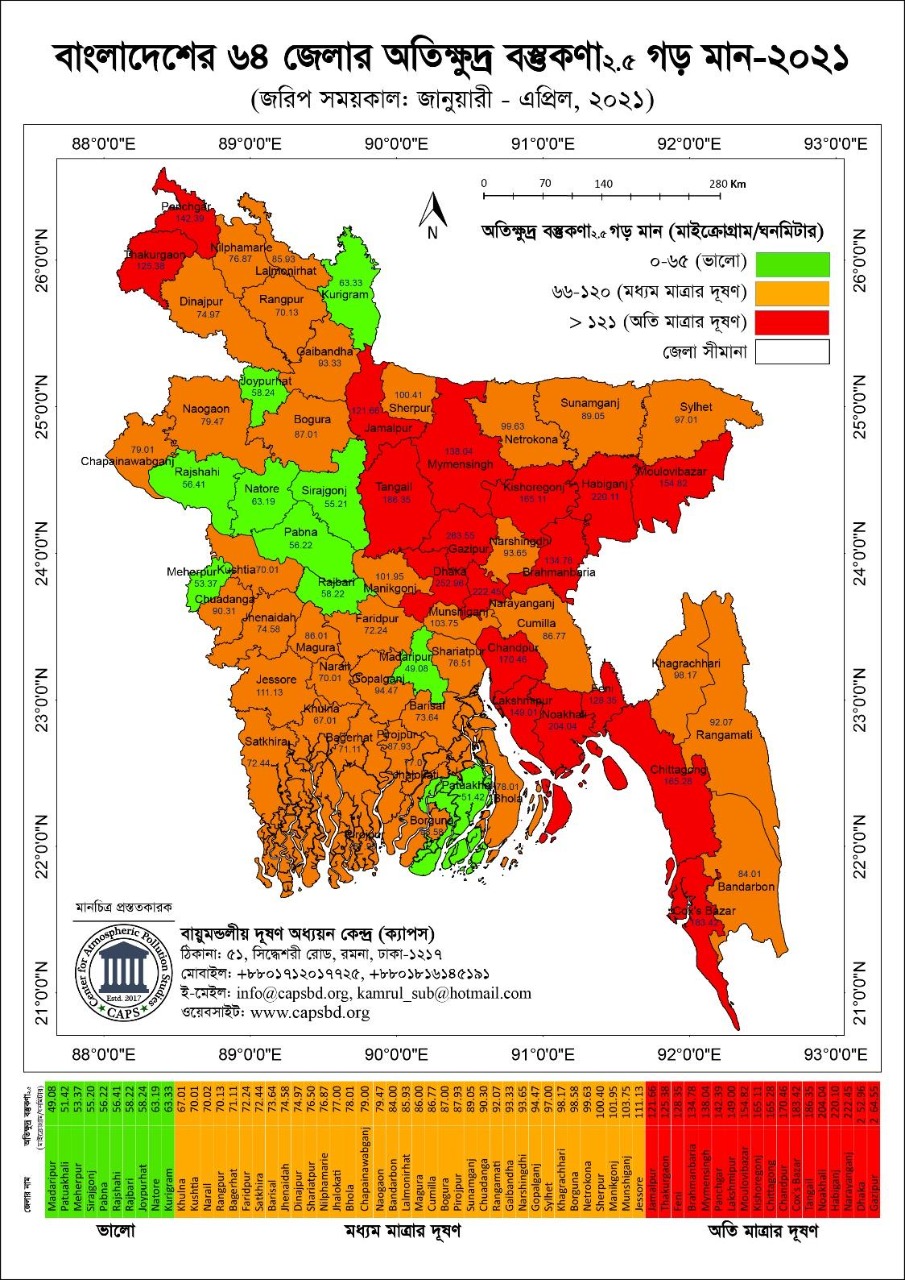The level of ultrafine particulate, the most toxic pollutants called PM 2.5, in Dhaka was nearly 17 times higher than the permitted level of World Health Organisation (WHO); finds a recent nationwide survey carried out by Centre for Atmospheric Pollution Studies (CAPS), a unit of Stamford University Bangladesh.
PM 2.5 pollutants are minuscule particulates, 20 times smaller than the diameter of hair particles, those can penetrate deep into the respiratory system and trigger a bevy of respiratory, cardiac & other diseases including fatal ones like cancer.
Incidentally, Bangladesh along with India & Pakistan were the three most polluted countries in the world when it comes to highly toxic PM 2.5 pollution.
The study, carried out within January and July in 2021 across the length & breadth of Bangladesh, found that the average PM 2.5 level in Bangladesh during 2021 – 102.4 microgram per cubic meter of air – was about 7 times higher than the WHO specified day limit of 15 microgram & about 1.6 times above Bangladesh day limit ; 65 microgram.
“Out of the 64 districts studied, Gazipur had highest average PM 2.5 pollution, 263.45 microgram; while Dhaka was the second-worst with 252.9 followed by Narayangonj with 222.45 microgram”, said professor Ahmed Kamrujjaman Majumder, head of environment science of Stamford University & the project lead.
“Constant digging of roads & construction, emissions from about 1200 brick kilns around the cities, pollution from few thousands moderate & large industries as well as from unfit vehicles & burning of garbage are the main reasons behind the high air pollution level within the top three cities in Bangladesh”, further said Majumder.
The study report, a copy of which is with
The Plurals, shows Hobigunj, Noakhali, Tangail, Coxbazar, Chandpur, Chattagram & Kishoregunj are the other significantly polluted cities in Bangladesh.
Bangladesh cities with maximum PM 2.5 pollution |
| Serial |
Districts
|
PM 2.5 (microgram/cubic meter of air) |
| First |
Gajipur |
263.51 |
| Second |
Dhaka |
252.93 |
Third |
Narayangunj |
222.45 |
Fourth |
Hobigunj |
220.11 |
| Fifth |
Noakhali |
204.01 |
| Permissible limit: Bangladesh (day) |
65 |
| Permissible limit: WHO (day) |
15 |
The level of pollution was found to be moderate in Satkhira, Khulna in Bagerhat areas falling within Sundarban.
In contrary, areas like Madaripur, Potuakhali & Meherpur were found to be the least polluted areas with fewer constructional work; found by the researchers in those zones.
Majumder told on Friday that according to their study, the pollution in Bangladesh is mostly local in origin. “Our research shows that neither Bangladesh receives substantial amount of pollution from India, nor India from Bangladesh”, added Majumder.
Sometimes back, Kalyan Rurdra, Chairman of West Bengal Pollution Control Board, India claimed that about one-fifth of West Bengal Pollution comes from Bangladesh, based on a study carried out by IIT, Delhi.
The CAPS study further finds that the PM 2.5 concentration was highest in mixed demographic areas ; 111.9 microgram, followed by commercial areas with 111.4 microgram, road crossings with 110.8 microgram; and then pollution in domestic, industrial & sensitive areas.
Least pollution was recorded from rural areas; 94.02 microgram.
Professor Majumder pointed that out of 64 districts studied, only 10 had air quality within permissible limit, while 36 had moderately polluted air & 18 having highly polluted air.
Experts & activists claimed that there were minimum efforts to control air pollution through science based integrated planning and its implementation within the country.
“The air pollution has spread all over Bangladesh with Dhaka being the central point, leading to high impact on exposed population”, said Shorif Jamil, general Secretary of Bangladesh Paribesh Andolan (BAPA). Jamil demanded provision of appropriate laws & setting up of green court to counter the rising pollution in the country.
Rashida Begum, a physician and reproductive medicine expert, said that high level of PM 2.5 exposure, apart from triggering respiratory problem, also causes sterility within both males & females; as well as, is a reason behind abortion, congenital defect & ill development of neural system within children.

